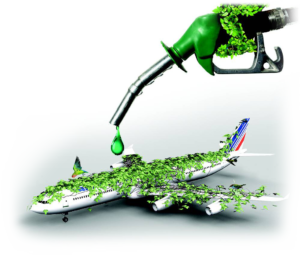Sustainability Within the Aerospace Industry
By Susie Henaghan

Let’s look to see how companies are engineering a cleaner and brighter tomorrow with today’s practices:
From the Ground Up
Aircraft manufacturers have made exponential leaps in the production phase that have been environmentally efficient compared to their predecessors. Additive manufacturing has become a sustainable option for part creation, as there is essentially zero-waste when compared to the older production of machining from metal billets.  With traditional manufacturing, material is cut away leading to a considerable amount of leftover waste. Recycling leftover waste requires excess labor and becomes time-consuming as there are many processes put into place to get the metal back to the working form. Additive manufacturing adds material to the part rather than cutting it away. With additive manufacturing, any excess metal powder is then collected in bins for re-use during the next production cycle, with little to no waste. GE Aviation has used additive manufacturing to build a fuel nozzle that weighed 25% less than the original. With more lightweight materials being used in constructing airplanes, less carbon emissions will be released. Every 5.5 lbs. of weight on a plane equates to 1 ton of carbon emissions per year. With the simple changes in part production—sustainability is attainable.
With traditional manufacturing, material is cut away leading to a considerable amount of leftover waste. Recycling leftover waste requires excess labor and becomes time-consuming as there are many processes put into place to get the metal back to the working form. Additive manufacturing adds material to the part rather than cutting it away. With additive manufacturing, any excess metal powder is then collected in bins for re-use during the next production cycle, with little to no waste. GE Aviation has used additive manufacturing to build a fuel nozzle that weighed 25% less than the original. With more lightweight materials being used in constructing airplanes, less carbon emissions will be released. Every 5.5 lbs. of weight on a plane equates to 1 ton of carbon emissions per year. With the simple changes in part production—sustainability is attainable.
Fueling the Cause
Sustainable Aviation Fuel, or SAF, has taken to the skies as aviation companies are introducing renewable bio-fuel which reduces their carbon footprint up to 80% when compared to traditional fossil jet fuel. Jet Blue Airways has stated that starting this year, they will be purchasing Sustainable Aviation Fuel from Neste, the world’s largest producer of renewable diesel, and fueling flights from San Francisco with this eco-friendly fuel. Similarly, Alaska Airways is also opting-in to use bio-fuel which aids Washington State’s Clean Fuel Program. With growing technology and aircraft production, improvements in fuel efficiency have exponentially grown by almost 20% with each new generation. This has led to today’s modern aircraft producing 80% less CO2 per seat than the first jets in the 1950s.
and fueling flights from San Francisco with this eco-friendly fuel. Similarly, Alaska Airways is also opting-in to use bio-fuel which aids Washington State’s Clean Fuel Program. With growing technology and aircraft production, improvements in fuel efficiency have exponentially grown by almost 20% with each new generation. This has led to today’s modern aircraft producing 80% less CO2 per seat than the first jets in the 1950s.
Accurate and efficient navigation is also leading the way to help decrease carbon emissions. The United States has implemented NextGen enhancements to the National Airspace System (NAS) and is expected to save about 2.8 billion gallons of fuel through 2030.
The Third Era
We are now entering the third generation of aviation where we are beginning to see newer and more resourceful methods of aircraft production, as well as advancing propulsion and accelerating technologies. This progress will eventually become the cornerstone of future aviation endeavors—making the past eras of the Wright Brothers and our 1950s Jet age forefathers proud. Environmentally conscious methods will be put into place in all areas of development, manufacturing, and production practices. During the 2019 Paris Air Show, seven CTOs of the world’s leading aerospace manufacturers released a joint statement demonstrating how they will work collaboratively by sharing approaches to drive eco-conscious aviation and reach the industry-wide ATAG targets. Airbus, Boeing, Dassault Aviation, GE Aviation, Rolls-Royce, Safran, and United Technologies Corp., signed the statement, agreeing to combine their efforts to remain committed to making the future of sustainable aviation a tangible possibility.
Environmentally conscious methods will be put into place in all areas of development, manufacturing, and production practices. During the 2019 Paris Air Show, seven CTOs of the world’s leading aerospace manufacturers released a joint statement demonstrating how they will work collaboratively by sharing approaches to drive eco-conscious aviation and reach the industry-wide ATAG targets. Airbus, Boeing, Dassault Aviation, GE Aviation, Rolls-Royce, Safran, and United Technologies Corp., signed the statement, agreeing to combine their efforts to remain committed to making the future of sustainable aviation a tangible possibility.
Alloys Efforts
Here at Alloys International, Inc., we recognize the importance of industry environmental sustainability, and actively make efforts to help reduce our carbon footprint! By implementing office policies & procedures such as recycling, eliminating paper waste, and using eco-friendly cleaning chemicals and metal dust filtration, we are helping to ensure that our future will be better and brighter!


